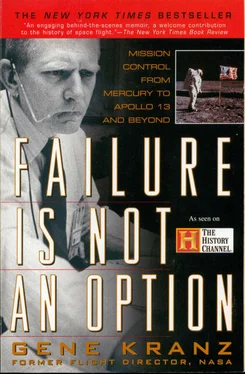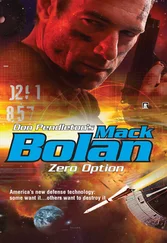CM- command module (reentry portion of the Apollo spacecraft that contains the crew)
CMP- command module pilot
CONTROL- Lunar Module engineer in the MCC responsible for propulsion, attitude control, and primary and abort guidance and navigation systems, including computer hardware
Cryo- cryogenic (oxygen and hydrogen fuels stored at very cold temperatures)
CSM- Command and Service Module—Apollo
EECOM- Gemini or CSM engineer in MCC responsible for electrical, environmental, communications, cryogenic, fuel cell, pyrotechnic, and structural systems
EVA- extravehicular activity
FCD- Flight Control Division—provides majority of flight controllers to the MCC
FCOB- Flight Control Operations Branch—provides assistant flight director and procedures, develops mission rules
FIDO- flight dynamics officer (the MCC specialist in launch and orbit trajectories)
FOD- Flight Operations Directorate organization; also, flight operations director in the MCC
FTE- flight test engineer
G- acceleration due to gravity forces
GMT- Greenwich Mean Time, also referred to as Zulu (Z) time
GNC- Gemini/CSM engineer in MCC responsible for propulsion, attitude control, guidance, and navigation systems, including computer hardware
Go NoGo- decision process to continue or abort a mission activity
GRR- guidance reference release
GSFC- Goddard Space Flight Center (Greenbelt, Maryland)
GT-- Gemini-Titan-(followed by mission number)
GUIDO- (pronounced GIDO) MCC specialist in navigation and computer software. During Gemini, this included the Titan II guidance system.
INCO- MCC engineer responsible for combined CSM, LM, EVA, and Rover instrumentation, communications, command, and television systems
KSC- John F. Kennedy Space Center, Florida
LM- lunar module, previously called lunar excursion module (LEM)
LMP- lunar module pilot
LOI- lunar orbit injection (maneuver to enter into lunar orbit)
LOS- loss of signal
LRC- Langley Research Center (Langley Field, Virginia)
MA-- Mercury-Atlas-(followed by mission number)
Mach- ratio of airspeed to the speed of sound at a given altitude
MCC- Mercury Control Center at Cape 1960-65 or Mission Control Center at Houston 1965-1972
MET- mission elapsed time (time since liftoff)
MPAD- Mission Planning and Analysis Division—responsible for analytic trajectory design
MR-- Mercury-Redstone-(followed by mission number)
MSC- Manned Spacecraft Center, Houston, Texas, used through 1973
MSFC- Marshall Space Flight Center (Huntsville, Alabama)
NACA- National Advisory Committee for Aeronautics
NASA- National Aeronautics and Space Administration
NoGo- the decision to cancel a planned event
OD- operations director position in Mercury Control, changed to FOD for Gemini and Apollo
PAO- public affairs officer—position in the MCC to release mission information
POGO- rapid up-and-down maneuver that if continued would destroy launch vehicle
psi- pounds per square inch
PTC- passive thermal control
RCS- Reaction Control System—small propulsion jets for attitude control and small maneuvers
Refsmmat- reference to stable member matrix—technique for conversion between coordinate systems
RETRO- retrofire officer—the MCC specialist in reentry trajectories
RSO- range safety officer—responsible for protecting landmass across the world from errant rockets
SCE- signal conditioning electronics
SimSup- simulation supervisor—the leader of the training team in the MCC
SM- service module—portion of Apollo CSM that contained main engines and power systems
SPAN- spacecraft analysis team—small group in MCC to access design and manufacturing
SPC- stored program command, a command stored in a computer or program that will activate a function at a specific clock time
Stay NoStay- Time-critical decision to remain on the Moon or lift off at the next opportunity
SYSTEMS- Mercury control center engineer responsible for electrical, attitude control, display, and structural systems
TEC- trans-Earth coast
TEI- trans-Earth injection (maneuver to return the spacecraft to Earth from the Moon)
TELMU- Lunar Module engineer responsible for electrical, environmental, communications, pyrotechnic, structural, and EVA systems
TLC- translunar coast
TLI- translunar injection (the maneuver to take the spacecraft to the Moon)
TM- telemetry
Trench- the MCC trajectory team consisting of the RETRO, FIDO, and GUIDO
TVC- thrust vector control (rocket steering mechanism)
Z- Zulu—shortened term for Greenwich Mean Time used in logs and messages
Manned Mercury Remote Sites
BDA- Bermuda
ATS/RKV- Atlantic Tracking Ship/ Rose Knot Victor—designation changed in middle of the program
CYI- Canary Islands
KNO- Kano, Nigeria
ZZB- Zanzibar
IOS/CSQ- Indian Ocean Ship/ Coastal Sentry Quebec—designation changed in middle of program
MUC- Muchea, Australia
WOM- Woomera, Australia—tracking station in a remote desert location on a military test range
CTN- Canton Island—FAA ground beacon for aircraft navigation in South Pacific
HAW- located at edge of Waimea Canyon on Hawaiian island of Kauai
CAL- California, site located at Point Arguello
GYM- Guaymas, Mexico
TEX- Corpus Christi, Texas
Manned Gemini Remote Sites
CYI- Canary Islands
CRO- Carnarvon, Australia
HAW- located at edge of Waimea Canyon on Hawaiian island of Kauai
GYM- Guaymas, Mexico
CSQ- Coastal Sentry Quebec ship
RKV- Rose Knot Victor ship
TEX- Used as a training site only
Aaron, John
and Apollo 1 fire
and Apollo 11
and Apollo 12
and Apollo 13 crisis
Abort
in mission rules
training sessions
Abort command
Abort switch problem
Agena
Africa tracking sites
Air Force
Agena upper-stage rocket
Atlas program
Fighting 69th
man in space program
satellite missions
6555th test wing
Aldrich, Arnold (Arnie)
and Apollo 13 crisis
Aldrin, Edwin (Buzz)
Apollo 11
as CapCom
EVA training
America
American flag
on Moon
Читать дальше












